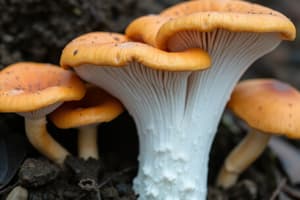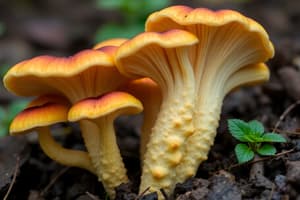Podcast
Questions and Answers
How do puffballs release spores?
How do puffballs release spores?
- Through fragmentation
- Through small pores on the surface
- Through a puffing action (correct)
- Through budding
What is the process by which some fungi reproduce asexually?
What is the process by which some fungi reproduce asexually?
- Budding
- Fragmentation (correct)
- Puffing
- Filamentation
In addition to sexual reproduction, what other type of reproduction can yeast species commonly undergo?
In addition to sexual reproduction, what other type of reproduction can yeast species commonly undergo?
- Budding (correct)
- Puffing
- Filamentation
- Fragmentation
What is the process by which fungi reproduce sexually known as?
What is the process by which fungi reproduce sexually known as?
What are the male sex cells in fungi called?
What are the male sex cells in fungi called?
Why do filamentous fungi switch between sexual and asexual reproduction methods?
Why do filamentous fungi switch between sexual and asexual reproduction methods?
Which structure will develop from a dikaryon after the fusion of spermatia and ascogonia cells?
Which structure will develop from a dikaryon after the fusion of spermatia and ascogonia cells?
What are the visible reproductive structures of fungi called?
What are the visible reproductive structures of fungi called?
Flashcards are hidden until you start studying
Study Notes
Fungi Reproduction: Exploring the Fascinating World of Fungi
Fungi, often referred to as "fungy" in a casual context, are a diverse and fascinating group of organisms that play a crucial role in the ecosystem. In this article, we'll delve into the world of fungi reproduction, focusing on the various ways fungi reproduce and the unique mechanisms they employ to propagate their species.
Sexual Reproduction in Fungi
Fungi reproduce sexually through a process known as fungal mating or conjugation. This process involves the fusion of two haploid cells (n) called gametangia. The two types of gametangia are antheridia (male) and ascogonia (female).
- Antheridia are specialized structures that contain gametes called spermatia (male sex cells) that are released into the environment.
- Ascogonia are specialized structures that contain ascogonia cells (female sex cells).
When the spermatia and ascogonia cells fuse, a new diploid cell called a dikaryon is formed. The dikaryon will then develop into a hypha (filamentous structure) and eventually into a fruiting body.
Fruiting Bodies
Fruiting bodies are the reproductive structures of fungi. There are two main types:
- Mushrooms - These are the fruiting bodies that many people are familiar with. They are the visible part of the fungus and are responsible for producing spores.
- Puffballs and pore fungi - These are less well-known fruiting bodies. Puffballs release spores through a puffing action, while pore fungi release spores through small pores on the surface.
Sexual Spore Formation
Once the fruiting bodies mature, they release spores that contain the genetic information of the fungus. These spores are dispersed by wind, water, or animals. When the spores land in a suitable environment, they germinate and develop into new fungal structures, starting the life cycle all over again.
Asexual Reproduction in Fungi
In some cases, fungi reproduce asexually through a process known as fragmentation or budding. This process involves breaking off a portion of the fungal filament and growing new hyphae from the broken-off segment. Asexual reproduction is particularly common in yeast species.
Filamentous Fungi
Filamentous fungi reproduce through a combination of both sexual and asexual reproduction methods. They can switch between these two modes of reproduction based on their environmental conditions.
Conclusion
Fungi are a diverse and fascinating group of organisms that play a crucial role in the ecosystem. They reproduce through a variety of mechanisms, including sexual and asexual reproduction. Fungi's ability to reproduce in different ways allows them to adapt to changing environmental conditions and ensures the continuation of their species. Understanding fungi reproduction can provide valuable insights into the fascinating world of fungi and their ecological significance.
Studying That Suits You
Use AI to generate personalized quizzes and flashcards to suit your learning preferences.




